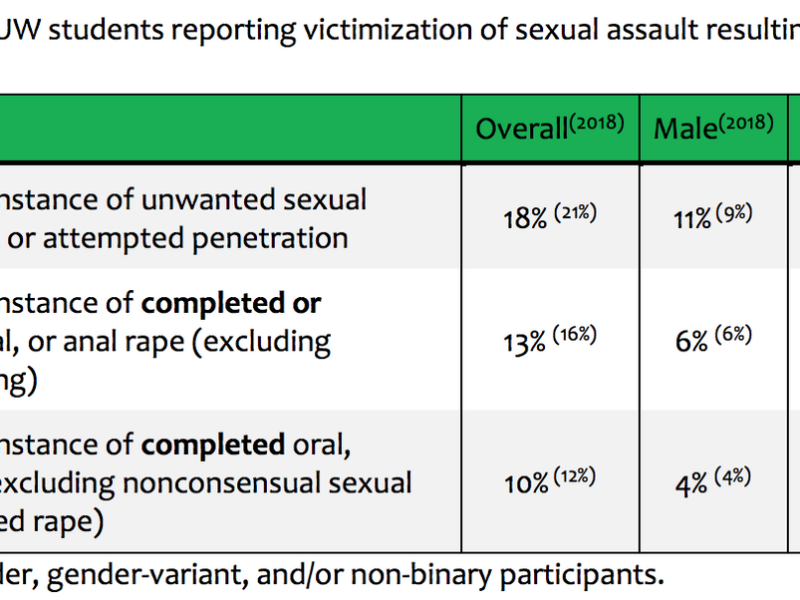Sexual Misconduct Dropped at University of Wyoming, Survey Found
Numbers comparable to other college campuses even with decline
- Published In: Other News & Features
- Last Updated: May 30, 2023

The percentage of University of Wyoming students who reported experiencing at least one instance of sexual assault in a recent survey has dropped from about 27% to 18% since the last campus survey was conducted in 2018. (Courtesy photo from the University of Wyoming Sexual Misconduct Climate Report – 2023)
By Shen Wu Tan
Special to the Wyoming Truth
Sexual assault at the University of Wyoming has declined in the last several years, a new survey found.
UW students who reported experiencing at least one incident of sexual assault on campus dropped by 9% since the last survey was conducted in 2018. The findings, released last week, revealed that 405 of 2,223 respondents (or 18.2%) reported experiencing sexual assault while enrolled at the university.

“It’s not actually good news until we see those numbers get down to zero or as close as possible to zero, but it’s encouraging news,” Matt Gray, a UW psychology professor and expert in sexual violence prevention who led the campus survey, told the Wyoming Truth Sunday. “So the fact that we are seeing on the heels of investment in and partial implementation of an evidence-based prevention program and starting to see those numbers trend down a bit is certainly heartening and encouraging, and we hope that continues.”
That prevention program is called Green Dot, and it uses a comprehensive approach to violence prevention by encouraging potential bystanders to engage in proactive behaviors that discourage sexual violence. Over 1,200 students, faculty and staff members have received Green Dot training, and plans to expand the program are underway.
Green Dot trainings at UW began in January 2020, but the program didn’t fully launch until 2021 or so due to the COVID-19 pandemic, Gray noted. However, some trainings took place over Zoom during the initial years of the pandemic.
UW implemented Green Dot after the release of the 2018 campus survey on sexual misconduct. The Administrator Researcher Campus Climate Collaborative survey, which was created by 25 prominent researchers and scholars with expertise in sexual misconduct research and policy, was primarily used as part of the recent UW survey. It also included questions from the Revised Illinois Rape Myth Acceptance scale, the Patient Health Questionnaire-2 and the Primary Care Post-Traumatic Stress Disorder Screen.
For the survey, sexual assault was defined as any nonconsensual sexual touching or any attempted or completed act of nonpermissive oral, anal or vaginal sex using force, threat of force or incapacitation.
UW researchers conducted the survey and collected the data from Oct. 19 to Nov. 20. Participation was open to all undergraduate, graduate and professional students. Of those who took part in the survey, 59.5% were female, 37.2% were male and 3.3% were transgender, gender-variant or non-binary.
The survey found that 23% of women, 11% of men and 12% of transgender, gender-variant or non-binary students reported experiencing sexual assault. It also found that there was an 18% decline in reports of attempted or completed rape from 2018 and a 27% reduction in reported intimate partner and dating violence since that year.
Among those who reported experiencing multiple sexual assaults, 52% said it was the same perpetrator while 48% said multiple perpetrators sexually assaulted them.
Additional survey findings revealed that 28% of those experiencing sexual assault never told anyone about the incidents prior to the survey. Only 6% of those experiencing assault disclosed the instances to UW faculty or staff; only 6% made a complaint or filed a report formally to the university, such as through the Dean of Students office.
Although reports of sexual misconduct decreased, the numbers of incidents are comparable to the prevalence of sexual violence among college students nationwide, Gray said.
Thirteen percent of all college students experience rape or sexual assault through physical force, violence or incapacitation, according to the Rape, Abuse and Incest National Network (RAINN). The numbers are higher among undergraduate students than graduate and professional students. Among undergraduate students, 26.4% of females and 6.8% of males experience rape or sexual assault. Among graduate and professional students, 9.7% of females and 2.5% of males experience rape or sexual assault, RAINN statistics reveal.
To reduce sexual misconduct and assault, Gray said it is important to continually invest in Green Dot. The UW survey researchers also recommend increased visibility of reporting tools and greater post-assault support for survivors who might experience post-traumatic stress disorder and other psychological conditions.
“Despite encouraging reductions in sexual assault prevalence since 2018, it is still the case that nearly 1 in 5 UW students have experienced assault since enrolling at UW,” the survey researchers wrote in their report. “Effective treatment of PTSD and other sequelae of sexual violence requires evidence-based, best practice approaches, rather than broad supportive counseling. The sole clinic on campus that routinely provides these treatments typically reaches capacity during fall semester and runs a waitlist the rest of the year. Increased therapy resources and capacity are critical in addressing survivors’ mental health needs in a timely fashion.”
For the upcoming academic year, all incoming UW students will be required to participate in the Saddle Up program, which includes information from Green Dot, Gray noted. Bystander intervention training also will be offered throughout the year.













